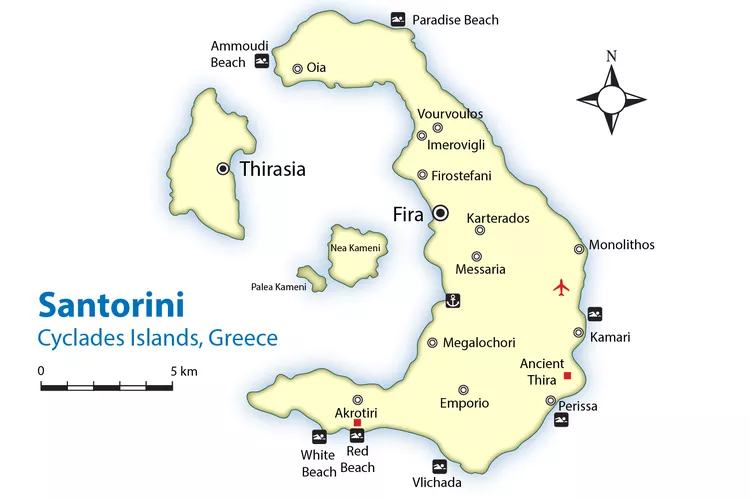Summary
Why Go to Santorini?
Santorini, also known as Thera or Thira, is a breathtaking volcanic island and the southernmost member of the Cyclades. This remarkable destination boasts 13 charming villages and a population that swells from under 14,000 to much larger during the vibrant summer months. During this time, its renowned beaches become hubs for sun-soakers and adventure-seekers alike. The island’s stunning volcanic structure, which created its iconic landscape, is mapped out remarkably.
Moreover, Santorini offers unparalleled experiences, ranging from some of the world’s best beaches and captivating scenery to a collection of ancient cities and high-quality dining options. Beverage enthusiasts will relish the opportunity to taste some of Greece’s finest wines. Notably, the island’s tomatoes are famous, and you can explore their unique history and cultivation methods at the Santorini Tomato Industrial Museum.
Getting to Santorini
The National Airport of Santorini, conveniently located near Monolithos and just eight kilometers southeast of Fira, provides easy access to the island. Domestic flights from Athens take approximately an hour and a half, followed by a mere 20-minute journey to Fira.
Furthermore, Greece’s ferry system operates extensively during summer, making it essential to plan ahead if traveling during this peak season. The ferry ride from Piraeus (Athens’ port) can take 7-9 hours, yet opting for a catamaran or hydrofoil can decrease travel time significantly. Once you arrive in Santorini, frequent ferry connections are available to other Cyclades islands, Rhodes, Crete, and even Thessaloniki. Ferries from Rhodes also set sail to Turkey.
Places to Visit on Santorini
As Santorini’s capital, Fira is elegantly perched on a cliff 260 meters above the Aegean Sea, providing awe-inspiring views. Here, you’ll find the archaeological museum hosting remarkable artifacts from the Minoan settlement of Akrotiri, located south of the modern village. The Megaron Gyzi Museum showcases a fascinating collection of images depicting Fira before and after the devastating earthquake of 1956. In addition to its culture, Fira’s old port serves cruise boats, while ferries operate from the southern port, catering to tourists with various shops, including a notable focus on jewelry.
Imerovigli connects seamlessly to Fira through a picturesque footpath with stunning views that create memorable photographs.
Oia, renowned for its breathtaking sunset views, particularly near the castle walls, is a quieter alternative to Fira, though it still attracts many visitors during summer evenings.
Perissa boasts what many consider the island’s best beach, a sprawling 7-kilometer stretch of black sand, lined with numerous amenities. Additionally, Perissa hosts religious festivals on the 29th of August and 14th of September. Kamari features the island’s second black beach, along with diving centers for enthusiastic explorers.
If you’re after a more tranquil beach experience, Vourvoulos in the northeast offers some respite from the usual crowds.
Visit Megalochori to discover its intriguing churches while also enjoying Santorini’s excellent wines. Nearby, Messaria features picturesque winding streets, traditional churches, and delightful tavernas.
Emporio showcases a historical castle with winding streets that once confounded pirates.
At Akrotiri, the Museum of Prehistoric Thera stands alongside ancient excavations dating back to the 17th century BC. The stunning red sand beach of Akrotiri is close to the ancient site, offering boat services to various scenic beaches.
Santorini is also celebrated for its excellent wines, and visitors can indulge in tastings at venues like Domaine Sigalas Santorini.
When to Go
Santorini experiences a hot, yet dry climate in the summer, complemented by its beautiful beaches. In fact, it’s one of only two destinations in Europe classified with a desert climate. The optimal times for travel are in spring and fall; however, many visitors flock to the island during the lively summer months.
The Archaeology of Santorini
Aside from the archaeological museum in Akrotiri, two prominent archaeological sites on the island include Ancient Akrotiri and Ancient Thira. Sometimes referred to as the “Minoan Pompeii,” Ancient Akrotiri offers insights into life before the catastrophic volcanic eruption of 1450 BC, with no human remains discovered, suggesting the community successfully evacuated.
Meanwhile, Ancient Thira, perched high above Kamari and Perissa’s popular beaches, showcases its rich history, originating from Dorian occupation in the 9th century BC.
Where to Stay
Romantics often choose accommodations like hotels or villas boasting caldera views, particularly in stunning locales like Oia and Fira, although these options can be quite pricey. Alternatively, renting a villa or even experiencing a traditional cave house can provide unique lodging opportunities across the island.





